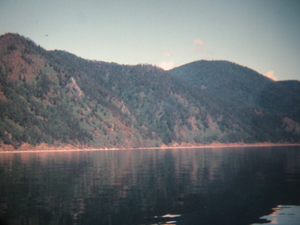Lake Baikal
|
|
Yenisei_basin_7.png
Lake Baikal (Russian: О́зеро Байка́л (Ozero Baykal)), a lake in southern Siberia, Russia, between Irkutsk Oblast on the northwest and Buryatia on the southeast, near Irkutsk. At 636 km long and 80 km wide, it is the largest freshwater lake in Asia (31,494 km²) and the deepest lake in the world (1637m—previously measured to 1620m). Its age is estimated at 25-30 million years, making it one of the world's most ancient lakes in geological history. It is unique among large, high-latitude lakes in that its sediments have not been scoured by overriding continental ice sheets. U.S. and Russian studies of sediment cores in the 1990s provide a detailed record of climatic variation over the past 250,000 years. Longer and deeper sediment cores are expected in the near future. If all the sediment were scoured from the lake, it would be 9 km deep.
The lake is completely surrounded by mountains, technically protected as a national park and contains 22 small islands, the largest, Olkhon, being 72 kilometers long. The lake is fed by some 300 inflowing rivers, the six main ones being Selenga, the source of some of Baikal's pollution, Chikoy, Khiloh, Uda, Barguzin and Upper Angara, and is drained through a single outlet, the Angara River.
The bottom of the lake is 1285 m below sea level and is the deepest continental rift on the earth. Its volume—23,000 km³—is approximately equal to the total volume of the 5 Great Lakes of North America, or to about 20% of the total fresh water on the earth.
Baikal is a young rift lake. The rift widens about 2 centimeters a year. The fault zone is seismically active: there are hot springs in the area and notable earthquakes every few years.
Few lakes can compete with Lake Baikal in terms of biodiversity. As many as 852 species and 233 varieties of algae and 1550 species and varieties of animals inhabit the lake; many of them are endemic species. The world-famous Baikal Seal (Phoca sibirica), the only mammal living in the lake, is found throughout the whole area of the lake.
Baikal is renowned for the unique clarity of its waters. Muted protest about the establishment of a wood pulp and cellulose plant at the south end of the lake, at Baikalsk, first planned in 1957, originated ecological awareness among educated Russians, though not among the Soviet bureaucracy. The plant still pours industrial effluent into Baikal's waters. The overall impacts of watershed pollution on Baikal and similar watersheds is studied annually by the Tahoe Baikal Institute (http://www.tahoebaikal.org/), an exchange program between the U.S. and Russian and Mongolian scientists and university graduate students started in 1989.
Very little was known about Lake Baikal until work began on the Trans-Siberian railway. The scenic loop encircling Lake Baikal required 200 bridges and 33 tunnels. At the same time (1896–1902) a large hydrogeographical expedition headed by F.K. Drizhenko produced the first detailed atlas of the contours of Baikal's depths.
See also
External links
- USGS survey fact sheet on Lake Baikal (http://marine.usgs.gov/fact-sheets/baikal/)
- World lakes database entry (http://www.ilec.or.jp/database/asi/asi-27.html) for Lake Baikal
- Information about Lake Baikal (http://www.baikalinfo.com)bg:Байкал
cs:Bajkal da:Bajkalsøen de:Baikalsee et:Baikali järv es:Lago Baikal eo:Bajkal fr:Lac Baïkal it:Lago Baikal nl:Baikalmeer ja:バイカル湖 pl:Bajkał pt:Lago Baikal hu:Bajkál-tó ru:Байкал sk:Bajkalské jazero sl:Bajkalsko jezero fi:Baikaljärvi sv:Bajkalsjön uk:Байкал zh:贝加尔湖

